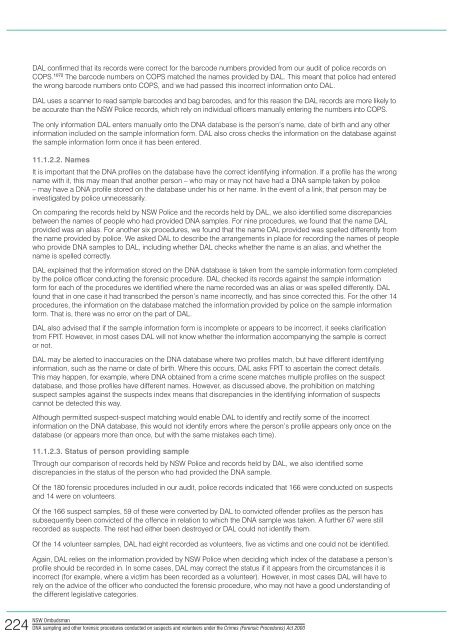Crimes (Forensic Procedures) Act 2000 - NSW Ombudsman - NSW ...
Crimes (Forensic Procedures) Act 2000 - NSW Ombudsman - NSW ...
Crimes (Forensic Procedures) Act 2000 - NSW Ombudsman - NSW ...
You also want an ePaper? Increase the reach of your titles
YUMPU automatically turns print PDFs into web optimized ePapers that Google loves.
DAL confirmed that its records were correct for the barcode numbers provided from our audit of police records on<br />
COPS. 1072 The barcode numbers on COPS matched the names provided by DAL. This meant that police had entered<br />
the wrong barcode numbers onto COPS, and we had passed this incorrect information onto DAL.<br />
DAL uses a scanner to read sample barcodes and bag barcodes, and for this reason the DAL records are more likely to<br />
be accurate than the <strong>NSW</strong> Police records, which rely on individual officers manually entering the numbers into COPS.<br />
The only information DAL enters manually onto the DNA database is the person’s name, date of birth and any other<br />
information included on the sample information form. DAL also cross checks the information on the database against<br />
the sample information form once it has been entered.<br />
11.1.2.2. Names<br />
It is important that the DNA profiles on the database have the correct identifying information. If a profile has the wrong<br />
name with it, this may mean that another person – who may or may not have had a DNA sample taken by police<br />
– may have a DNA profile stored on the database under his or her name. In the event of a link, that person may be<br />
investigated by police unnecessarily.<br />
On comparing the records held by <strong>NSW</strong> Police and the records held by DAL, we also identified some discrepancies<br />
between the names of people who had provided DNA samples. For nine procedures, we found that the name DAL<br />
provided was an alias. For another six procedures, we found that the name DAL provided was spelled differently from<br />
the name provided by police. We asked DAL to describe the arrangements in place for recording the names of people<br />
who provide DNA samples to DAL, including whether DAL checks whether the name is an alias, and whether the<br />
name is spelled correctly.<br />
DAL explained that the information stored on the DNA database is taken from the sample information form completed<br />
by the police officer conducting the forensic procedure. DAL checked its records against the sample information<br />
form for each of the procedures we identified where the name recorded was an alias or was spelled differently. DAL<br />
found that in one case it had transcribed the person’s name incorrectly, and has since corrected this. For the other 14<br />
procedures, the information on the database matched the information provided by police on the sample information<br />
form. That is, there was no error on the part of DAL.<br />
DAL also advised that if the sample information form is incomplete or appears to be incorrect, it seeks clarification<br />
from FPIT. However, in most cases DAL will not know whether the information accompanying the sample is correct<br />
or not.<br />
DAL may be alerted to inaccuracies on the DNA database where two profiles match, but have different identifying<br />
information, such as the name or date of birth. Where this occurs, DAL asks FPIT to ascertain the correct details.<br />
This may happen, for example, where DNA obtained from a crime scene matches multiple profiles on the suspect<br />
database, and those profiles have different names. However, as discussed above, the prohibition on matching<br />
suspect samples against the suspects index means that discrepancies in the identifying information of suspects<br />
cannot be detected this way.<br />
Although permitted suspect-suspect matching would enable DAL to identify and rectify some of the incorrect<br />
information on the DNA database, this would not identify errors where the person’s profile appears only once on the<br />
database (or appears more than once, but with the same mistakes each time).<br />
11.1.2.3. Status of person providing sample<br />
Through our comparison of records held by <strong>NSW</strong> Police and records held by DAL, we also identified some<br />
discrepancies in the status of the person who had provided the DNA sample.<br />
Of the 180 forensic procedures included in our audit, police records indicated that 166 were conducted on suspects<br />
and 14 were on volunteers.<br />
Of the 166 suspect samples, 59 of these were converted by DAL to convicted offender profiles as the person has<br />
subsequently been convicted of the offence in relation to which the DNA sample was taken. A further 67 were still<br />
recorded as suspects. The rest had either been destroyed or DAL could not identify them.<br />
Of the 14 volunteer samples, DAL had eight recorded as volunteers, five as victims and one could not be identified.<br />
Again, DAL relies on the information provided by <strong>NSW</strong> Police when deciding which index of the database a person’s<br />
profile should be recorded in. In some cases, DAL may correct the status if it appears from the circumstances it is<br />
incorrect (for example, where a victim has been recorded as a volunteer). However, in most cases DAL will have to<br />
rely on the advice of the officer who conducted the forensic procedure, who may not have a good understanding of<br />
the different legislative categories.<br />
224<br />
<strong>NSW</strong> <strong>Ombudsman</strong><br />
DNA sampling and other forensic procedures conducted on suspects and volunteers under the <strong>Crimes</strong> (<strong>Forensic</strong> <strong>Procedures</strong>) <strong>Act</strong> <strong>2000</strong>

















